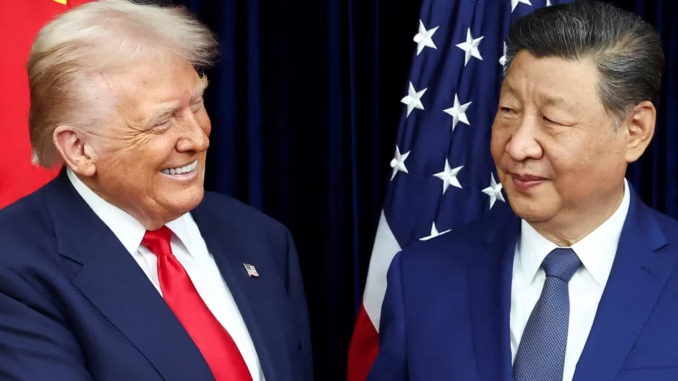
In a landmark meeting held in Busan, South Korea, on October 29, 2025, U.S. President Donald Trump and Chinese President Xi Jinping reached several agreements aimed at de-escalating ongoing trade tensions and fostering cooperation on global issues.
The summit, described by Trump as “amazing” and rated a “12 out of 10,” focused on key areas including trade tariffs, critical minerals, agricultural purchases, fentanyl control, and geopolitical collaboration on the Ukraine conflict.
This development comes amid heightened U.S.-China economic frictions, including recent Chinese export controls on rare earth minerals, which Trump had previously called a “roadblock.”
Got Taxes?
Got Questions on investing in oil and gas?
Summary of the Trump-Xi Meeting
The discussions yielded tangible outcomes on multiple fronts. Trump announced that China has agreed to resume large-scale purchases of U.S. soybeans, a move that revives a key agricultural trade link strained by prior tariffs.
On critical minerals, the leaders settled the rare earths dispute, with China committing to maintain an “open and free” flow of these essential resources for at least one year, delaying new export controls.
Rare earths are vital for technologies like electric vehicles, semiconductors, and renewable energy systems.
Trade tariffs saw immediate relief: Trump reduced fentanyl-related tariffs on Chinese goods from higher levels to 10%, in exchange for China’s pledge to curb the flow of the opioid into the U.S.
Additionally, China expressed interest in purchasing American energy resources, with potential deals involving Alaskan supplies still under negotiation.
Notably absent from the talks was any mention of Taiwan, a frequent flashpoint in U.S.-China relations.
Chinese state media emphasized a “consensus” on trade, while Trump’s readout highlighted strengthened bilateral ties and optimism for future deals.
Overall, the meeting signals a tactical truce rather than a full reset, with Trump indicating a broader trade deal could be signed “pretty soon.”
Emerging Investment Opportunities
This agreement could unlock several investment avenues, particularly in sectors sensitive to U.S.-China trade dynamics. Here’s a breakdown:
|
Sector
|
Key Opportunities
|
Rationale
|
|---|---|---|
|
Agriculture
|
U.S. soybean exporters and related agribusiness stocks (e.g., companies like Archer-Daniels-Midland or Bunge)
|
China’s renewed soybean purchases could boost demand, stabilizing prices and revenues after years of trade war disruptions.
|
|
Critical Minerals & Mining
|
Diversified mining firms, rare earth alternatives, and EV supply chain companies (e.g., MP Materials, Lynas Rare Earths)
|
The one-year reprieve on rare earth exports reduces immediate supply risks, potentially lowering costs for tech and green energy firms. Investors might look to non-Chinese sources for long-term hedges.
|
|
Energy
|
U.S. oil, gas, and LNG producers (e.g., ExxonMobil, Chevron)
|
China’s interest in American energy, including potential Alaskan deals, could increase exports, benefiting the sector amid global demand shifts.
|
|
Broader Markets
|
U.S.-China exposed ETFs (e.g., iShares China Large-Cap ETF) and tech/semiconductor stocks
|
Eased tariffs and trade optimism may lift market sentiment, with U.S. futures already edging higher post-meeting.
@Blindspot_ea
However, caution is advised as this is a short-term truce. |
Investors should monitor for a comprehensive trade deal, which Trump suggested is imminent, as it could further catalyze gains.
Risks remain, including enforcement of agreements and external factors like U.S. elections or global recessions.
Geopolitical Implications for Ukraine
The most intriguing aspect of the summit was the agreement to “work together” on resolving the Ukraine war, marking a potential shift in U.S.-China geopolitical alignment.
China has historically supported Russia economically and diplomatically, providing dual-use goods and helping circumvent sanctions, which has prolonged the conflict.
Trump’s push for cooperation could pressure Beijing to reduce aid to Moscow, aligning with U.S. interests in ending the war swiftly. This collaboration might involve joint mediation efforts or economic incentives for peace talks, potentially involving Russia.
For energy investors, a quicker resolution could stabilize global oil and gas markets, reducing volatility from disrupted supplies in Europe and the Black Sea region. However, skepticism persists: China’s readout omitted specific Ukraine details, and past U.S.-China pacts on global issues have faltered.
In the energy sector, de-escalation in Ukraine could lower natural gas prices and boost renewable investments, as focus shifts from wartime energy security to green transitions. Yet, if cooperation fails, renewed tensions might spike commodity prices, benefiting fossil fuel producers.
Overall, this meeting represents a pragmatic step toward U.S.-China detente, with ripple effects for global markets and geopolitics. Investors in energy and related sectors should stay vigilant for follow-up developments. We will be working on several follow-up stories and what investments to look at.
Got Questions on investing in oil and gas?
ENB Top News
ENB
Energy Dashboard
ENB Podcast
ENB Substack






Be the first to comment